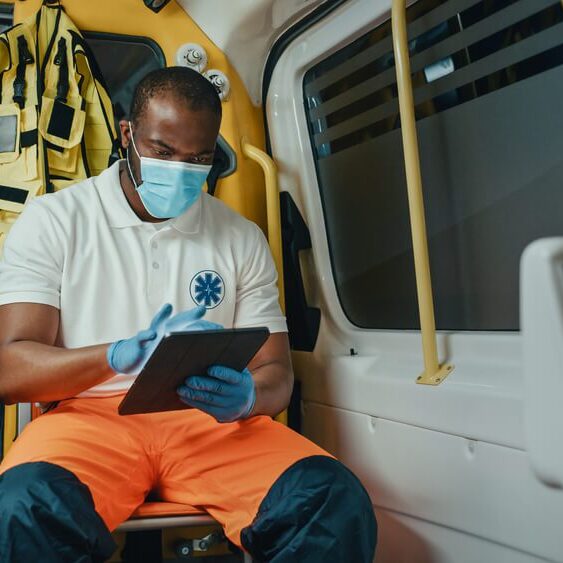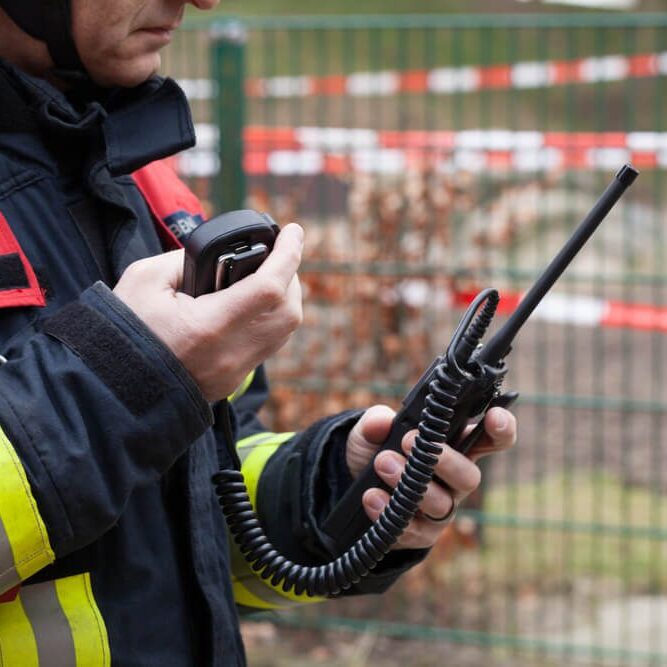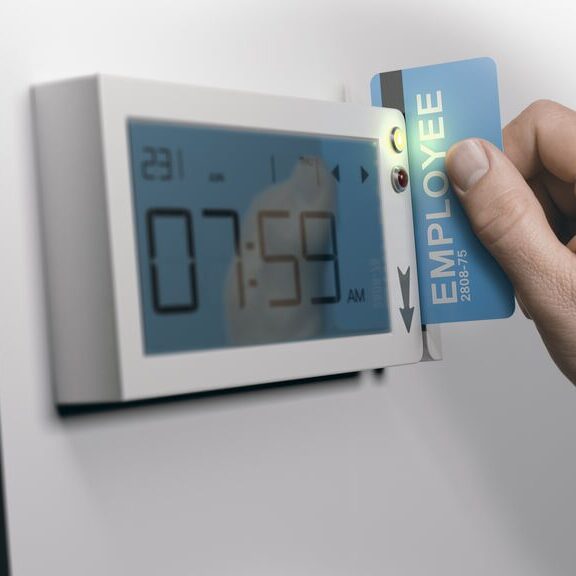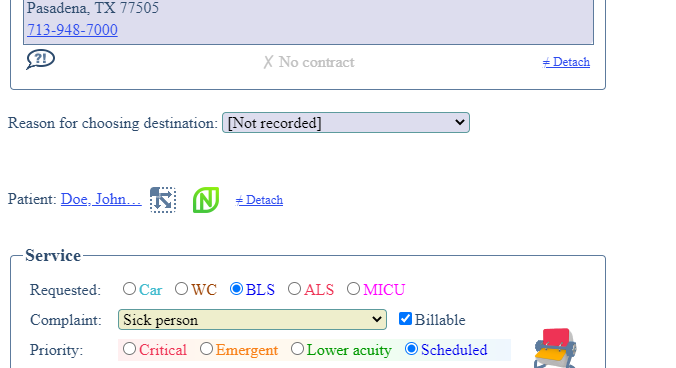AngelTrack Deployment Guide
Deploying AngelTrack means converting your organization over to mobile computing.
In a mobile organization, employees are no longer tied to specific locations or specific computers. Anyone can access AngelTrack and perform their role using any internet-connected device, including personally-owned tablets, phablets, and smartphones. Or work from home if you allow it.
Crews receive all of their orders, and access their patients' records, on their mobile devices. They can map their route, mark themselves on-scene, write a narrative, review a DNR document, browse a list of nearby ERs, email out a run report, log a fuel purchase, whatever, right on their tablet or smartphone.
No. More. Paper.
Decide On A Billing Strategy
Outsourced biller or in-house? If outsourced, is your biller willing to integrate, or will they remain detached?
In-house and integrated billers will have accounts in your AngelTrack cloud server and will login to it to perform billing tasks on your behalf. AngelTrack sorts all billing work-to-do into queues; you must decide who is responsible for each queue. For example, you may have a billing expert in-house who performs QA reviews and decides -- for each dispatch -- whether to file it with insurance; meanwhile your outside biller handles the claims, appeals, and EOBs of any dispatch approved for filing. Someone else entirely could take responsibility for generating facility and patient invoices, and processing invoice payments.

If you do purchase mobile devices for the company, your BLS+ crews need tablets with all of the following:
-
An integrated GPS/GLONASS/aGPS receiver, which AngelTrack needs for these purposes:
• Driving directions;
• Waypoint records; and
• Electronic PCS and Medicaid-PAN forms -
Armored cases;
-
Mobile data (4G/LTE/5G) service, as hotspots are not sufficient; and
-
A supported web browser:
• Microsoft Edge;
• Google Chrome; or
• Apple Safari

Meanwhile your wheelchair van drivers only need smartphones or phablets, since they don't have to write reports... but tablets work fine too, if you are standardizing on one kind of device for company use.
Decide whether to issue devices to vehicles, or to employees, or use a shared pool. Issuing devices to individual employees reduces losses but requires a lot more devices.
You will need a mobile internet service plan for each of your devices; wifi-only plans and mobile hotspots will be too frustrating. Use the EMS mobile device cost estimate page to work up an estimate for the total cost of ownership of your mobile devices.

Install Cellular Boosters In Vehicles
Even if you are in a big city where cellular service is plentiful, there will be areas where the signal is poor, or blocked by buildings. Furthermore, ambulances are metal boxes and so the signal is reduced for the crew member in the back.
A constant strong cellular signal is important not just for AngelTrack; it is also necessary for voice calls to and from the dispatch office, and for prearrival activation calls to the ER.
For these reasons, it is a good idea to install a cellular signal booster device in all EMS and fire vehicles. These devices are not mobile hotspots; rather they are general-purpose signal boosters that work for all carriers and all cellular devices. The leading brand is weBoost, but other brands are also available for your consideration.
In any case, the process will cost less than $1000 per vehicle, and it imposes no ongoing costs or maintenance.
You can also install them in stations, if your stations are metal buildings that block cellular signals.
Lock Down Company-Owned Mobile Devices
Best practice for company-owned mobile devices is to give each one a standard configuration and then lock it down with a password that blocks any change to the device configuration. Consider blocking the installation of new apps, too.
Then, register all company-owned mobile devices using whichever "find my device" app is available for that device. Give supervisors' devices the ability to access this tracking information in real time.


Arrange Storage And Charging For Company-Owned Devices
If you are not assigning a mobile device to each employee, then each crew station will need some kind of base for recharging and check-in and -out. Perhaps a set of shelves or nooks or trays, each with the appropriate charger and cable. Decide how devices are shared and checked-in/checked-out, and then publish it as policy, along with a warning about plugging in one's device each night so that it will be full in the morning.
One proven alternative to the hassle of charging cables is the Qi charging standard. It is built-in to many smartphones and tablets, and allows the device to be charged by simply laying it onto a Qi pad... no cable required. The Qi pads can be placed at stations and inside vehicles.
Establish Alternate Communications Channel And Protocol
Even if you use VoIP on your mobile devices, your dispatchers will need an alternate communications channel to reach crew members. It could be pagers, Nextel phones, short-wave radio mounted in the vehicle, or simply fall back on their personal cellphones. Whichever you choose, write and publish a protocol for how crews and dispatchers should behave in the event of loss of internet service.


Keep Stashes Of Old-Fashioned Paper Forms For Emergencies
Sooner or later your internet service will fail and you'll have to run for a couple of hours without it. In anticipation of that misfortune, you should stash a handful of old-fashioned paper PCR forms and signature sheets in each vehicle. The dispatch office, likewise, will need a stash of old-fashioned paper dispatch forms, just in case.
Provide Full-Sized Computers At Crew Stations
It can be tedious to type in a long run report on a touchscreen device (although bluetooth keyboards can help somewhat). So, at your crew stations there should be one or two desktop computers with full-size keyboards, for use by crews needing to finish up reports and corrections. Add a flatbed scanner if your mobile devices do not have adequate cameras for document photography.
AngelTrack supports all major operating systems and browsers, so it can be any sort of workstation. And there is no need for it be brand new; better to upgrade your dispatchers' computers to new dual-monitor workstations, and then hand down the old workstations for crew use.


Establish A Paper Document Workflow
Lay out a workflow for how paper documents -- handed to your crews -- are processed. Some should be photographed on-scene (AngelTrack can inhale documents by simply photographing them with a smartphone or tablet), or taken to the station for scanning and upload using a flatbed scanner. Perhaps it should be the crews doing the scanning, or perhaps it will be your back office.
The goal is zero paper, because every sheet of paper leaves a trail of destroyed man-hours in its wake. So, the more on-scene photographing your crews do, the less hours will be wasted in your billing office.
Bump Up The Computers In The Dispatch Office
Your dispatchers will benefit enormously from having dual-monitor computers. One monitor on the left for the active dispatch boards, and one on the right for the schedule of upcoming calls. You could hang a third monitor on the wall showing a real-time traffic map where all dispatchers can see it.
The quality of internet service at your dispatch office is critical; if it goes down, your dispatchers will have to fall back on mobile devices to run the dispatch board. So, if your internet service has a history of flakiness, upgrade it now. In the same vein, make sure your cable/DSL modem, your LAN switch, and your dispatchers' workstations are all on UPS power.


Configure All Computers And Devices For Military Time
AM/PM confusion is a serious hazard in EMS, especially in the dispatch office. Remove the ambiguity by configuring all company-owned computers and mobile devices to use military (24-hour) time, rather than AM/PM.
It also helps to set all computers and devices to use YYYY-MM-DD date format.
Set Policy For Timeclock Corrections
Set a clear and strict policy for what happens in the timeclock when an employee forgets to clock-in or -out. AngelTrack remembers and displays any HR edits to employee timecards, so every edit should have a consent form signed by the affected employee, in order to protect the company from labor law claims.


Set Dates For Switch-Over
Choose and publish official dates for the switch-overs. You will eventually be switching all of these:
-
From current dispatch software (or paper) to AngelTrack's dispatch system
-
From current PCR software (or paper) to AngelTrack's PCR
-
From current crew scheduler to AngelTrack's crew scheduler
-
From current timeclock to AngelTrack's timeclock
-
From current incident management system (if any) to AngelTrack's incident system
-
From current fuel-purchase tracking system to AngelTrack's system (or use both)
There should be a specific date for each of those switches. The day before the agreed date, round up your supervisors and do a dry run. If all goes well, everyone begins using the new system the next morning.
Configure Your AngelTrack Cloud Server
You have several hours' work to get your organization's employees, assets, and preferences input into your new AngelTrack cloud server. The first time you connect to it, you'll be taken to the Quick Start page; from there, follow the Quick Start Guide and you'll do just fine.


Send Crew Members To Training
The AngelTrack Training Portal is free, and will provide crew members with the instruction needed to login, clock-in, configure their profiles, record their certificates, run calls, and complete PCRs.
Upon finishing their training, crew members can print their own certificates of completion, in the event your state requires these to be kept on-file.
Have Your Legal Team Review AngelTrack's Signature Forms
AngelTrack's signature forms are pre-loaded with legal texts that are probably sufficient for any EMS company... but better safe than sorry. Show the texts (available from the Document Templates page under Settings) to your legal team and get their blessing.


Sign Up For NSure
AngelTrack provides live demographic verification and patient insurance discovery, via integration with the NSure / PayorLogic product. To make use of this, you must sign up for an NSure account.
To learn more, refer to the NSure Integration Guide.
Sign Up For Stripe
AngelTrack integrates with Stripe, to offer an invoice self-pay portal to your customers. Your customers can pay their invoices online, using credit card or ACH, without any need to call your office. All you need is a free Stripe account, which AngelTrack will configure for you.
To learn more, refer to the Stripe Integration Guide.


